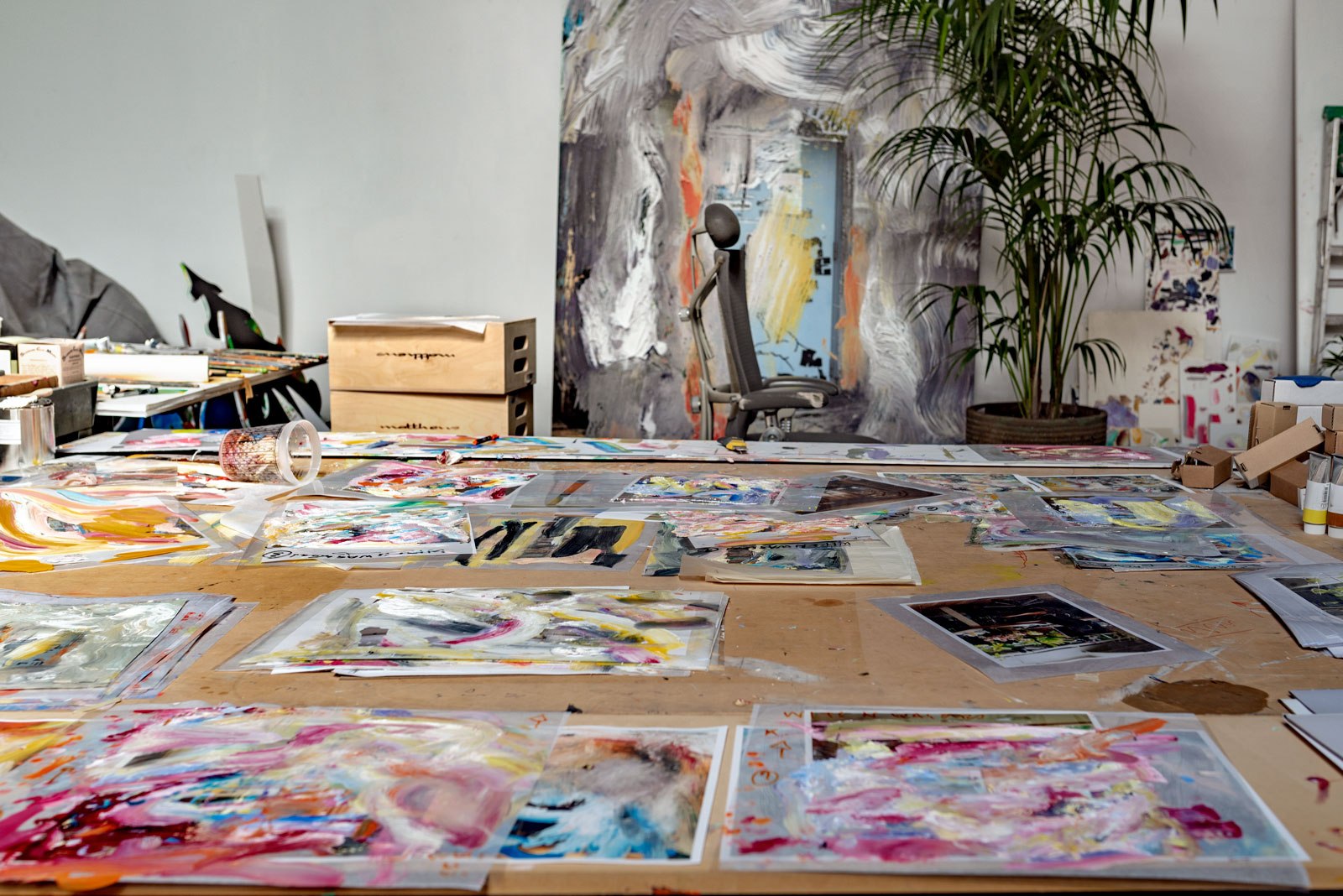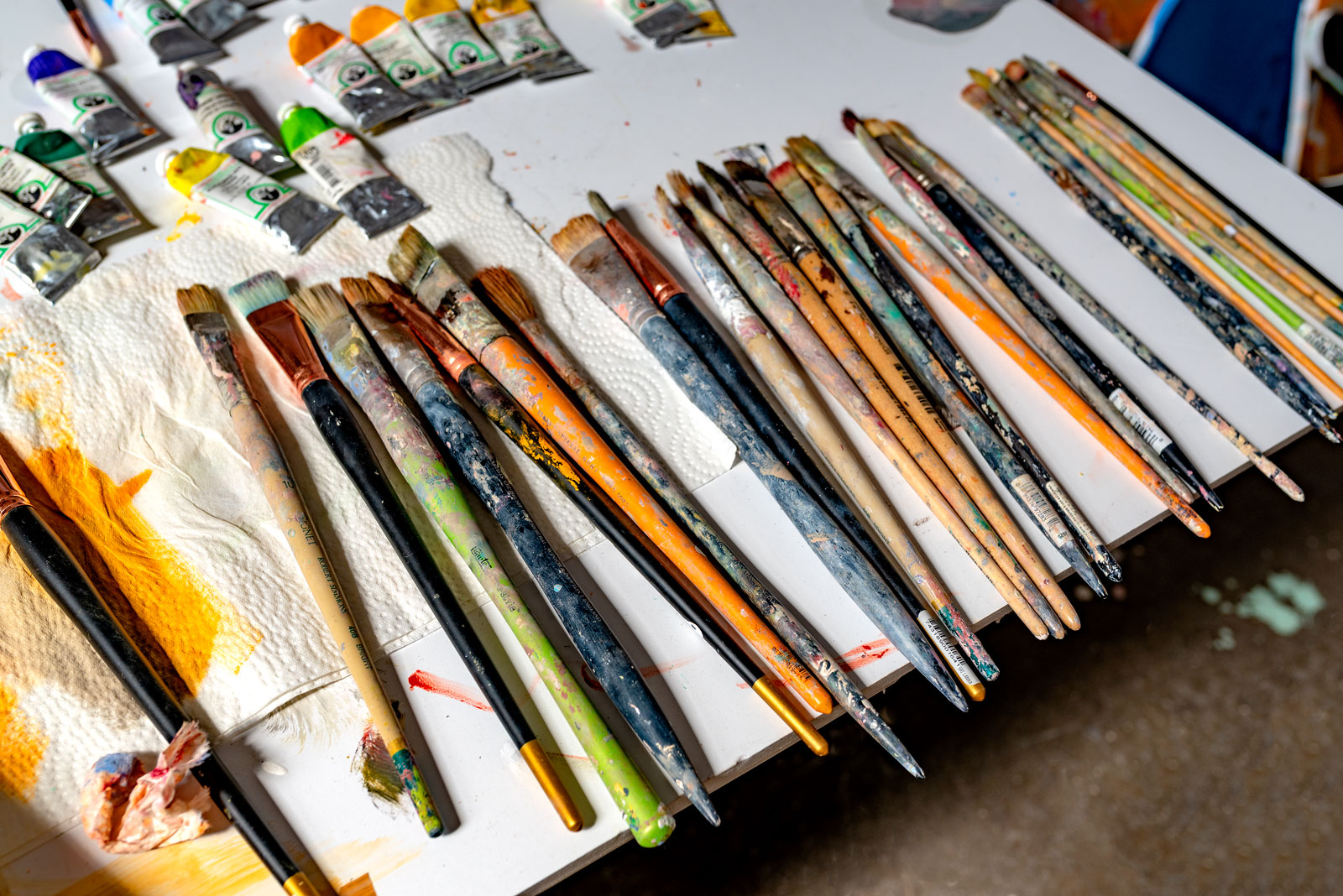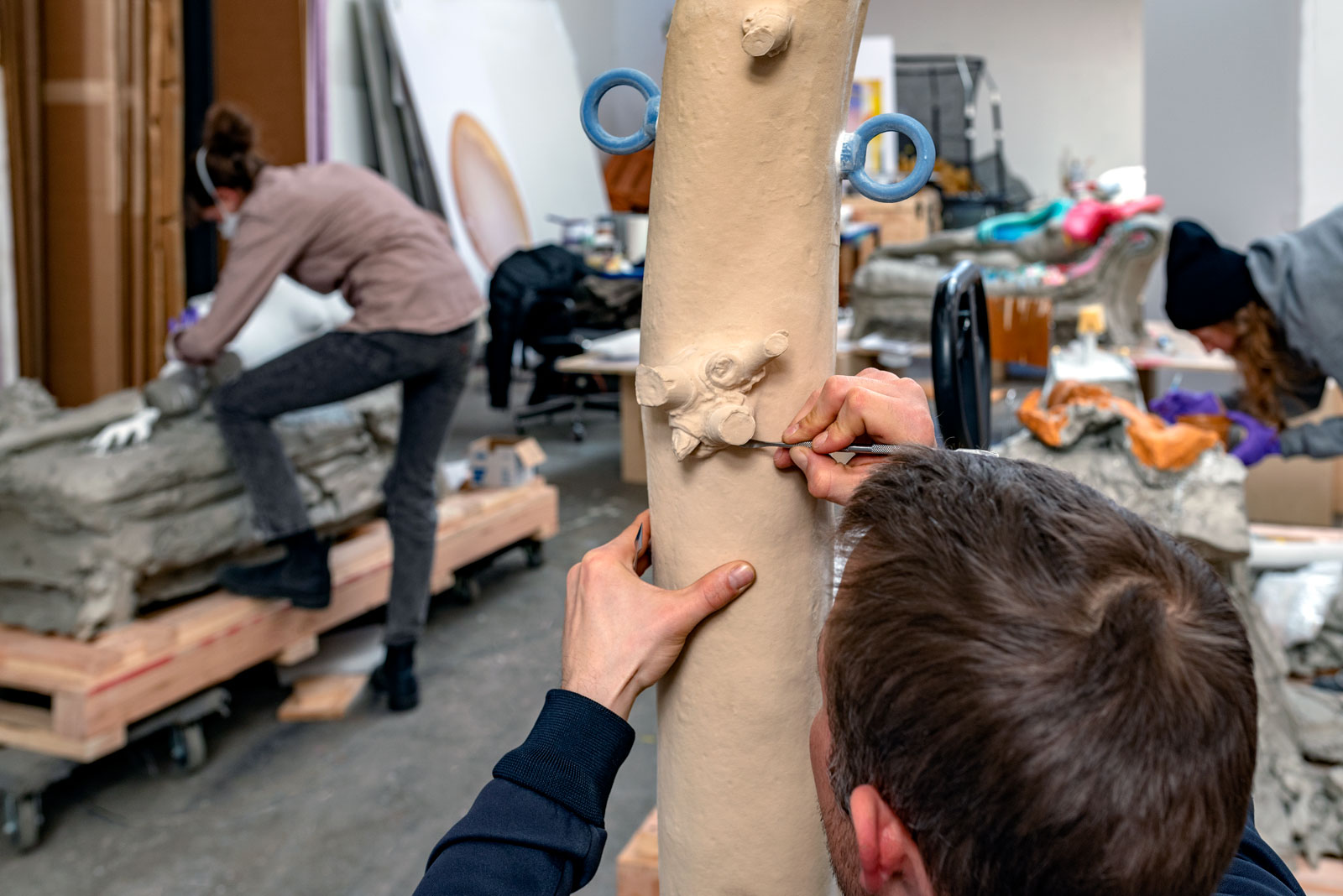In the luminous studio, nude women recline gracefully on couches. One of them, gleaming in the sun that streams through the skylight, looks as if she has been dipped in liquid gold like the woman in Goldfinger. Another, partly veiled in white oil paint, echoes Venus Victrix, Antonio Canova’s semi-nude life-size statue of Paolina Borghese, sister of Napoleon. And, a third one lies untouched on a sunny-coloredcouch that matches the color of her bystanders, three men made of foam. Amidst the lightly spiced fragrance of clay and paint, Swiss artist Urs Fischer explains. “I made one sculpture and then just to get started, I thought it might be nice to repeat it.” The actual process? “It’s fast and physical. It took me three hours. Then I painted it for another hour.” He left one couch purposefully without a figure, while on the last he placed a carrot instead of a figure, a touch of irreverent humor, both gentle and fiery. “The carrot marks the end,” says Fischer puckishly.
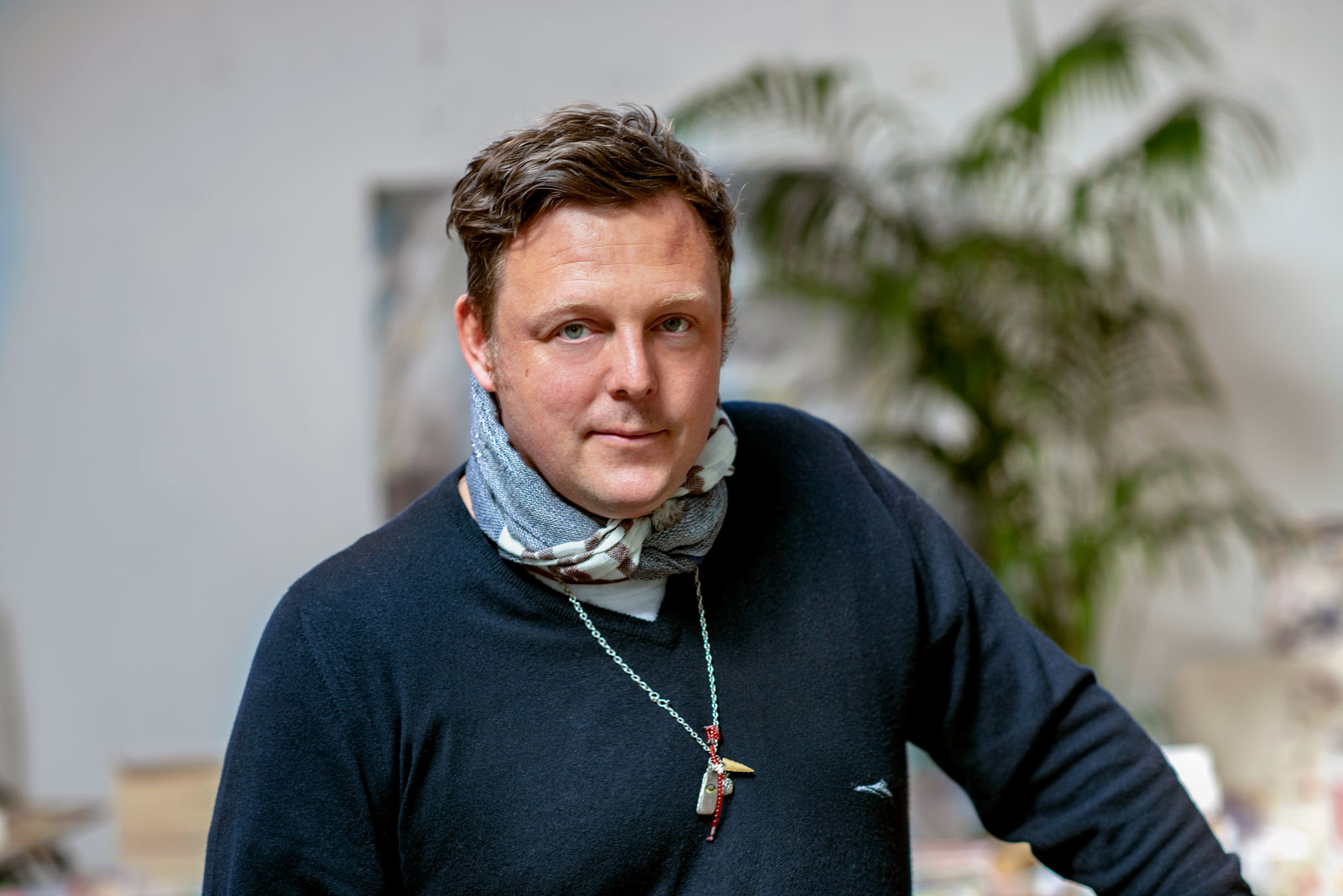
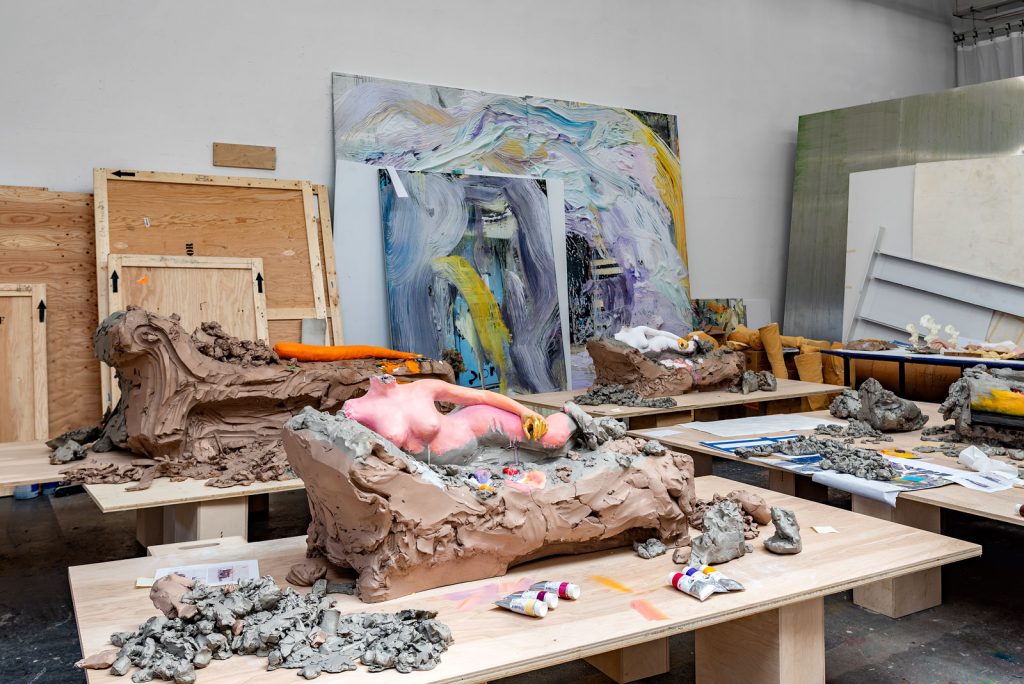
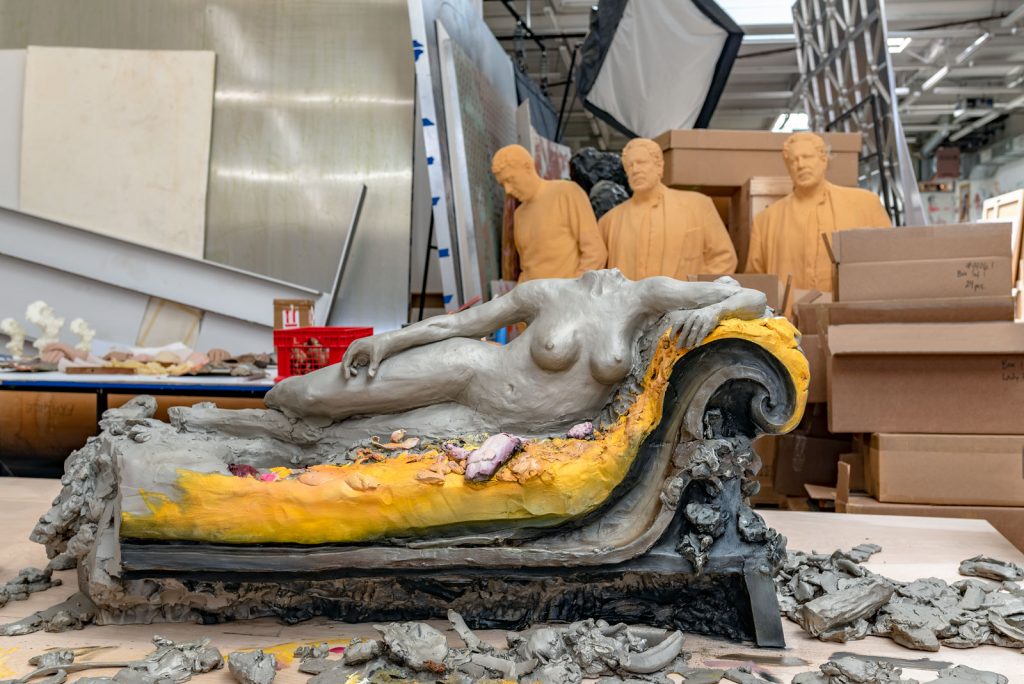
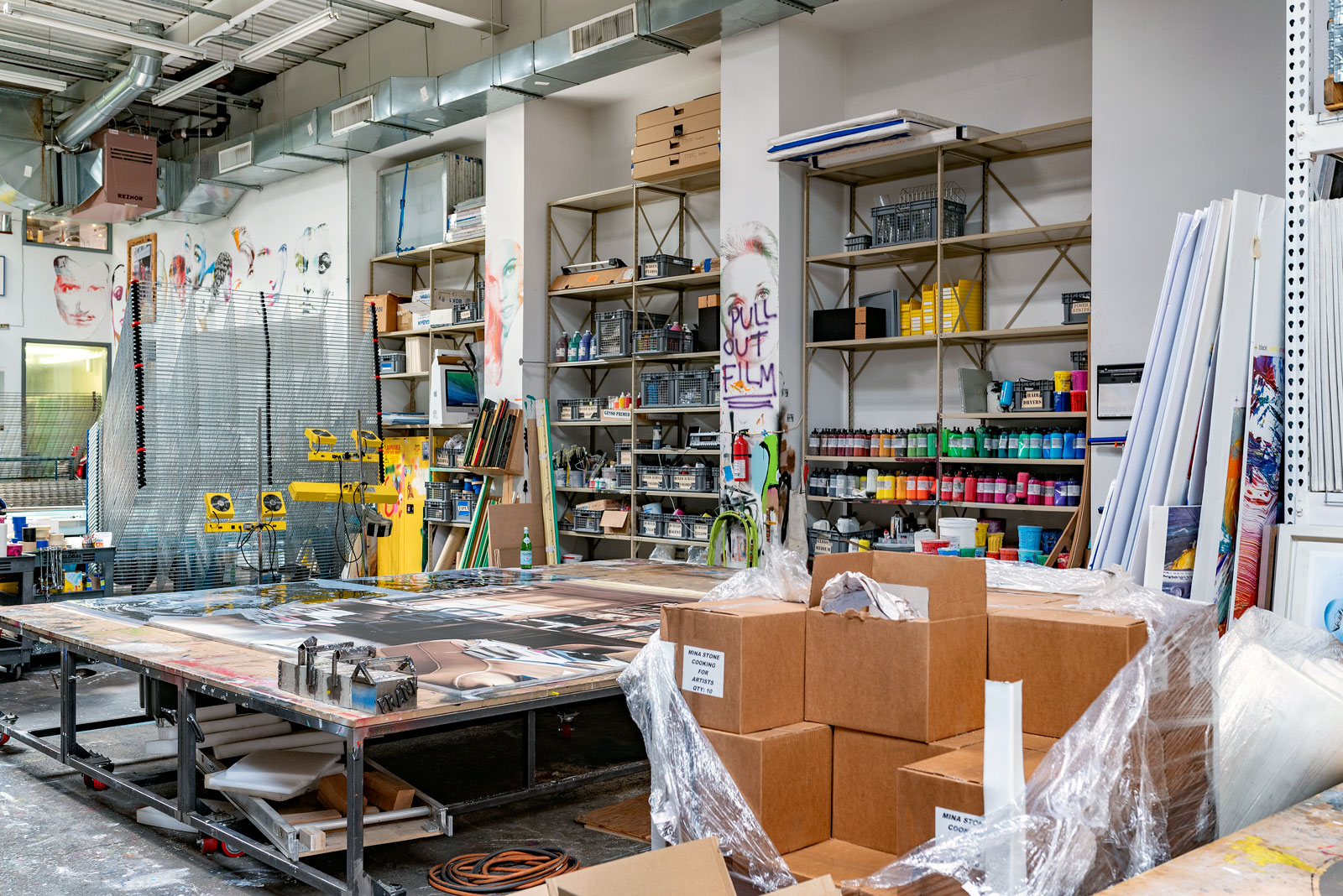

The big warehouse that serves as his studio is in the Red Hook neighborhood of Brooklyn, New York, close to the waterfront. It is cluttered with objects from artworks to paints to professional photography equipment. Fischer trained as photographer and has made photography a large part of his art. A colossal unfinished silkscreen print of a young Kirk Douglas greets visitors who may assume this panel belongs to his series, Problem Paintings, headshots of old Hollywood movie stars paradoxically juxtaposed with silkscreened pictures of either strikingly colourful pieces of fruit or shiny hardware like nails and screws. The effect is slightly Duchampian in nature like the moustache that Marcel Duchamp drew on a postcard reproduction of the Mona Lisa only this time, instead of using a moustache to decorate, Fischer uses organic or inorganic objects to partly conceal. “The panel has been there for 3 years. At first it was hidden and then I forgot about it. I took it out a month ago and I have just been experimenting with it.” Certain ideas like the Douglas panel need time to mature. “You think of something but you don’t know how to do it and years later you know how.”
One such new idea has sparked his imagination. He no longer attacks the photographs with pictures of objects, but rather with paintings. A large flat working surface has an equally large photograph of what looks like a private office. In the photograph we see the back of a chair overlooking a window and stacks of art books on the floor. Various family photographs decorate the shelves of the surrounding library. The intention is to superimpose a painting on it. Fischer has dozens of such studies on his desk. Next to them he has aligned his brushes, all of the same length but of different thickness, together with squeezed tubes of paints. The photograph eventually sinks beneath the painting so that only traces are visible.
Next to Julian is a three-piece suit made of plaster beautifully executed with penetrating realism and a pair of silicone hands on a used office chair that has a surreal flavor. This casual arrangement of artifacts is proof of Fischer’s palpitating magic and skillful diversity. He has fled the trap of the repetitive artist and has found refuge inside an extremely broad artistic vocabulary. “You have to trap the spirit of our times without getting trapped yourself.” What helps him is the fact that “I get bored easily and I become restless.”
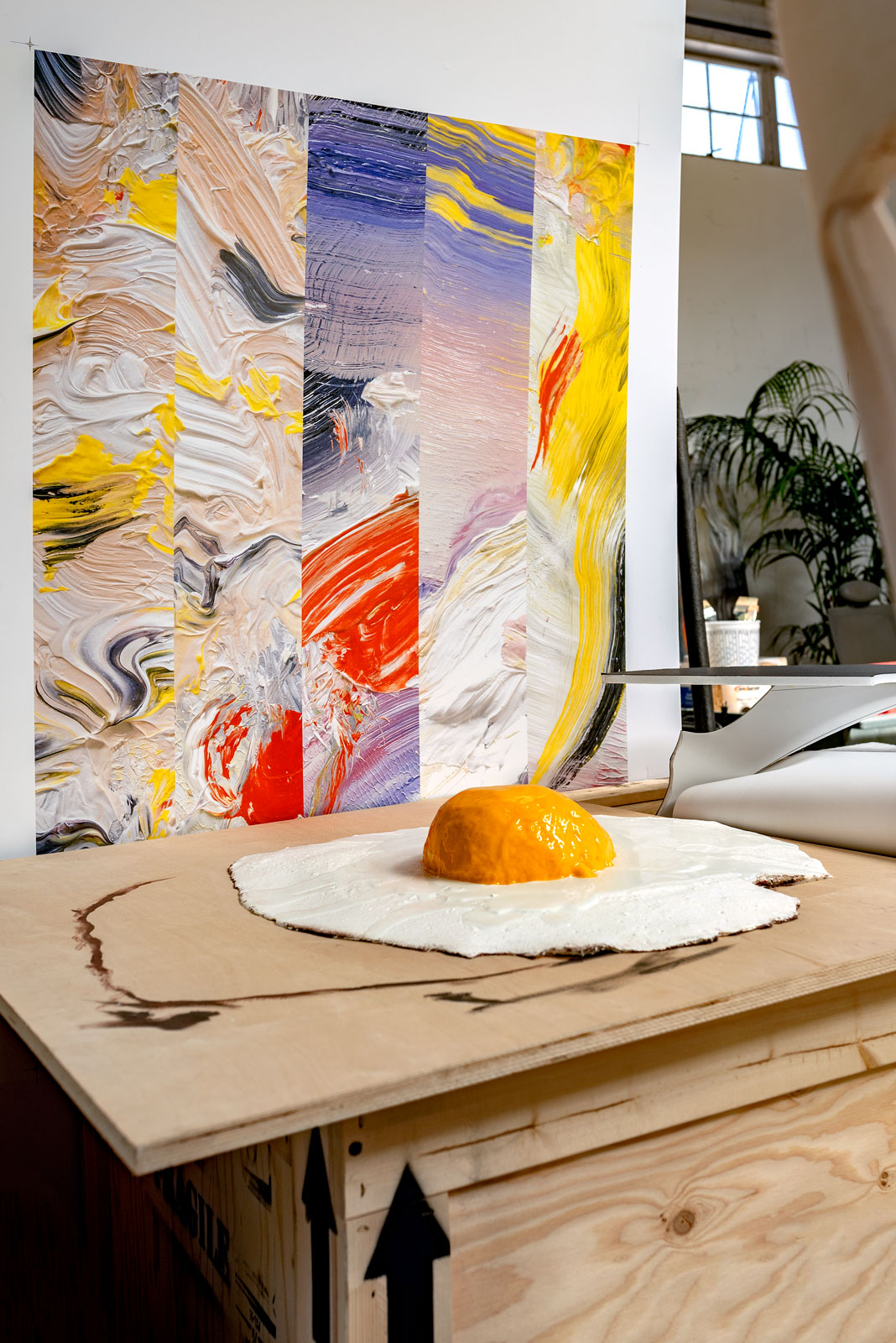

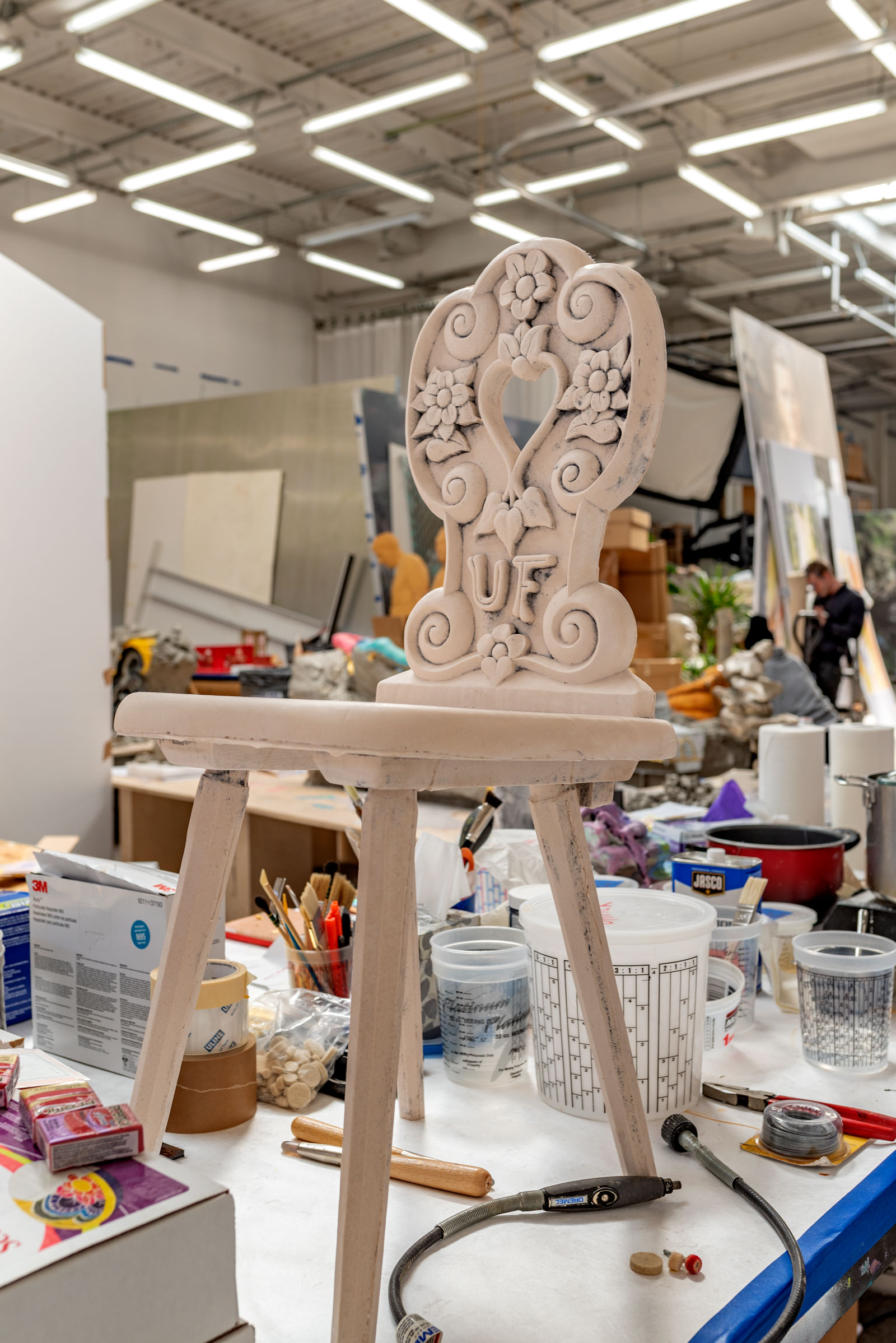
You have to trap the spirit of our times without getting trapped yourself.
Urs Fischer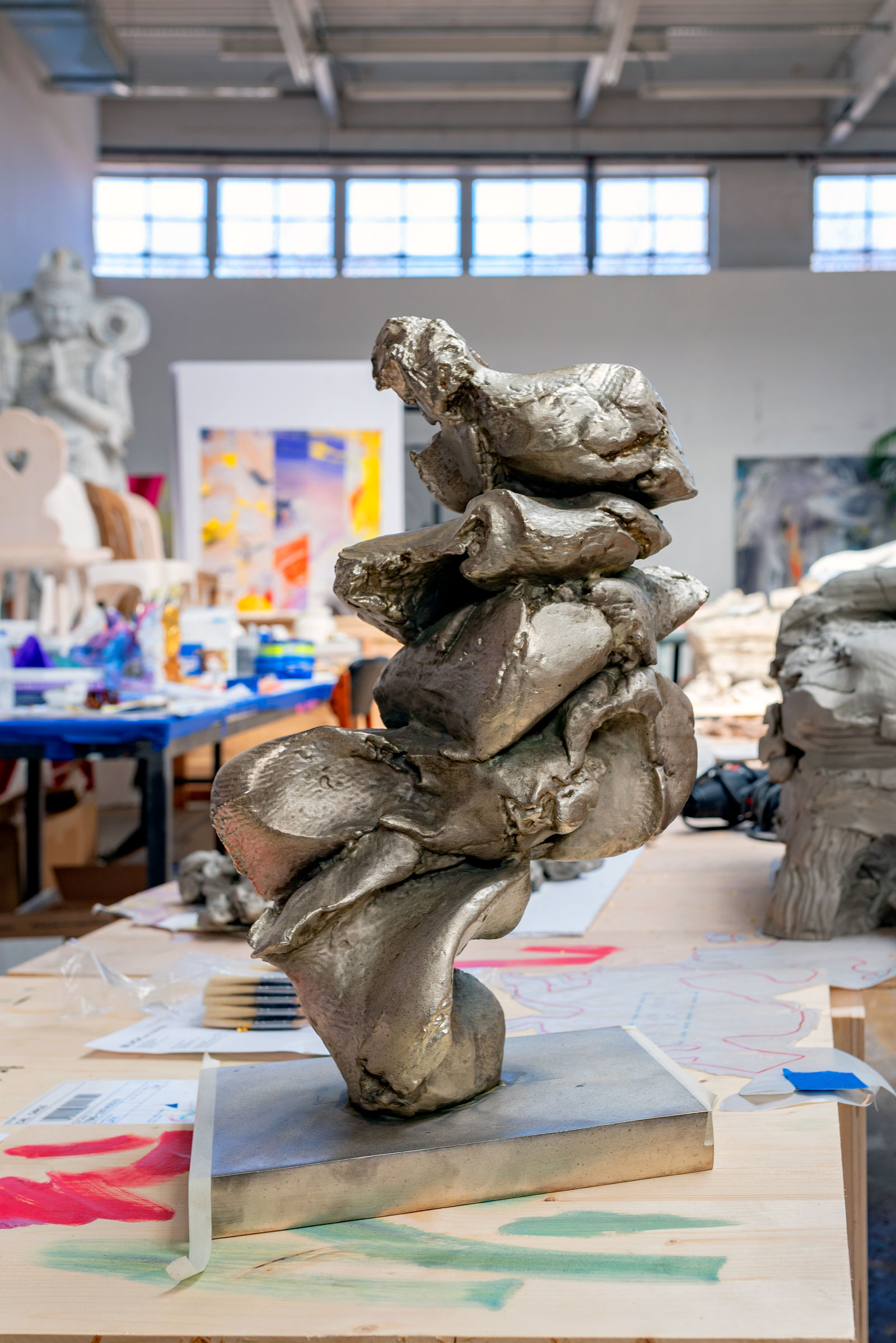
A small bronze piece, like an elegant trophy, shines in the middle of the studio. Fischer made the prototype by squishing clay with his fingers. The sculpture was subsequently 3D scanned and reproduced in durable metal in both small and monumental scales for the Untitled (Big Clay #7) (2008-2013) series. Scale is a lever that Fischer often uses to either compress or magnify objects. “If you see something big outside in the city, it looks very small. If you see something small in a big room, you can make a drama around it. A lot has to do with what you want the work to be. Or what physicality it should have.”
Fischer needs to send a message to his 6-year-old daughter, Lotti, who is on vacation with her mother. She has sent him a photograph of a curvilinear sun-bleached branch rising elegantly from aquamarine water that reminds me of his Spinoza Rhapsody, Cioran Handrail and Mackintosh Staccato (2006) pieces in which abstract expressionist lines float like giant intestines in the air. He smiles, and while he texts her back, my eyes stray, stopping for a moment on the wall where he has drawings she has made for him before spotting farther away a giant trampoline filled with foam bricks. “We try to keep it friendly,” he says. “I have a room like they have, just bigger.”
Artist/ dj / nightclub owner Spencer Sweeney shows up to discuss the details of Sweeney’s new book which Fischer’s publishing company Kiito-San is scheduled to produce. “Twice a year I make a book with someone I am close with. Someone I understand.” Because there is no real book now of what Sweeney does, “it will help him in many ways understand his work,” Fischer says in a voice not lacking in firmness. Having gone through every image that Sweeney has ever made, they are now editing his 400 – 500 page book.
Fischer roams about with Sweeney to supervise the work in the studio discussing at the same time a book he has read recently, Masanobu Fukuoka’s One Straw Revolution. “It’s about a Japanese guy, who decided to do that kind of farming where you don’t interfere with nature. He does not plough his grounds. He does not prune his trees. He just has some little tricks, like planting some clover in between. As the clover disintegrates and it covers the ground, this does not let the weeds grow. The idea is that he lets the natural ecosystem work and it is more philosophy than anything else. His revelation is that man knows nothing,” he tells me as he walks with slow deliberation pacing back and forth reminding me of the Socratic paradox I know that I know nothing.
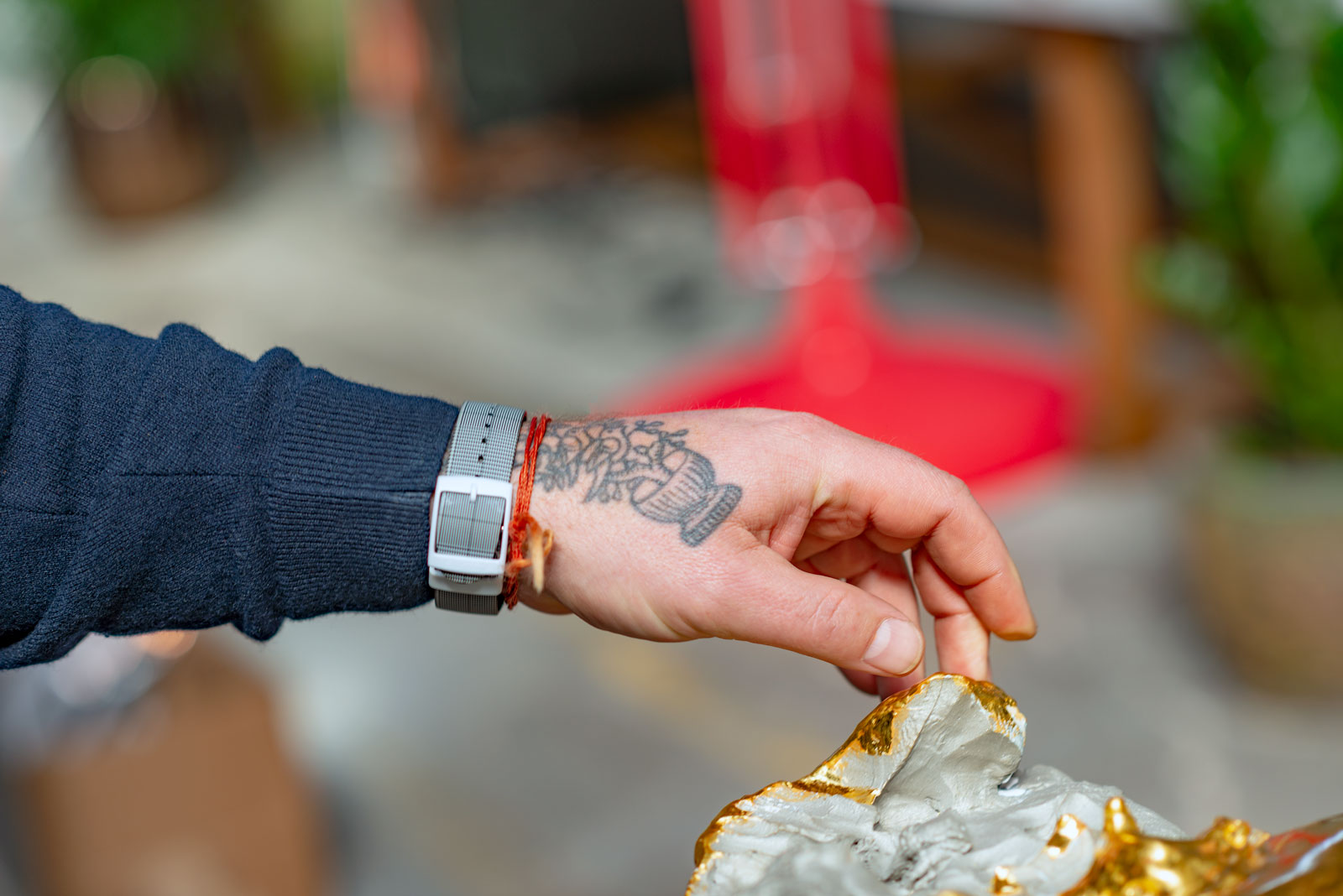
Some of Fischer’s assistants work on the sculptures, and he goes to them to fine tune the details, while others are working on computers reproducing some of his brushstrokes in bigger scale. He shouts “Bye Sophia!” waving to a little girl. “Her dad is half Greek,” he says, and it becomes obvious the studio keeps an open approach to a variety of cultures. “I tried living in many different places, but somehow I felt more comfortable here. There is a multicultural identity that never made me feel like a foreigner.” As for his decision to become an artist, “I just wanted to be free, even if it is an illusion.”
His studio has many Buddhist sculptures in the front yard where his car is parked. Everything there looks like an ad hoc installation. The trunk of his car has an I love Kippenberger sticker and the rear view mirror has a small pink panther figurine with a tail hanging upwards like an antenna. The door canopy reads, “If you do not have a plan for your life, then someone else will.” An alarming sign on the door warns “Beware of Dog.” Next to the door is a Buddhist marble sculpture, a poised Guan Yin sitting in the lotus position. Inside are two laughing Buddhas, one in dusty pink on his desk and a bigger one in white on the floor amidst green plants; two monumental rectilinear Buddhist sculptures face each other. Are you religious? I ask pointing to the rectilinear figure. “No. This is a temple guardian and it comes from a marble yard in Vietnam. But the marble isn’t pure. It is cast from some weird resin and it is only a model for the sculpture that people can choose from. When you donate something to the temple and you can afford it, you don’t want to be the cheap guy. The marble has to be clean,” he replies tranquilly.
Another temple guardian of sorts in the studio was fabricated in Vietnam by Peter Regli, who is also in the studio. Regli is editing his book documenting his Reality Hacking series, a 20-year oeuvre of artistic interventions performed in public spaces around the world. He scrolls through various projects on the computer screen noting that “after 9/11, if people see any irregularity, they report it immediately. So in that sense it has been more difficult to do those interventions in New York.” Nevertheless his Snow Monsters, funny looking marble snowmen in various stages of melting installed in the city’s Flatiron Plaza, have been a big success and warmly embraced by the public. “I think people are drawn to their happy Buddha-like nature. They bring joy to the public.” Fischer, equally drawn to them, proudly bought a monumental marble snowman and placed it facing the same direction as his temple guardian below the mezzanine.
Every day when the clock strikes 1 pm, Fischer invites his co-workers for a convivial lunch in the open plan kitchen on the mezzazine. He always sits at the head of the big rectangular table like a benevolent godfather. Today sandwiches and green rocket salad with Mediterranean dressing are served together with sparkling water flowing in natural profusion. There, I venture to ask him if food is important to his art, having in mind the cracked egg sunny side up that sits on a box, the cracked eggshell on the female portrait shot or the various fruits that show up in different experiments. “In my art I don’t know, in my life yes,” he says with a big and generous laugh. His benevolent expression changes to a more contemplative look when I ask about criticism and whether he finds it helpful. “If it’s done with intelligence and the same kind of ambition as the people that make things that get criticized. Yes. But at the end of the day, you could see an artwork as an offering. If you are ready to take something out of it, or if you reject it, it’s up to you. It’s there anyway. That’s what I like about art.”
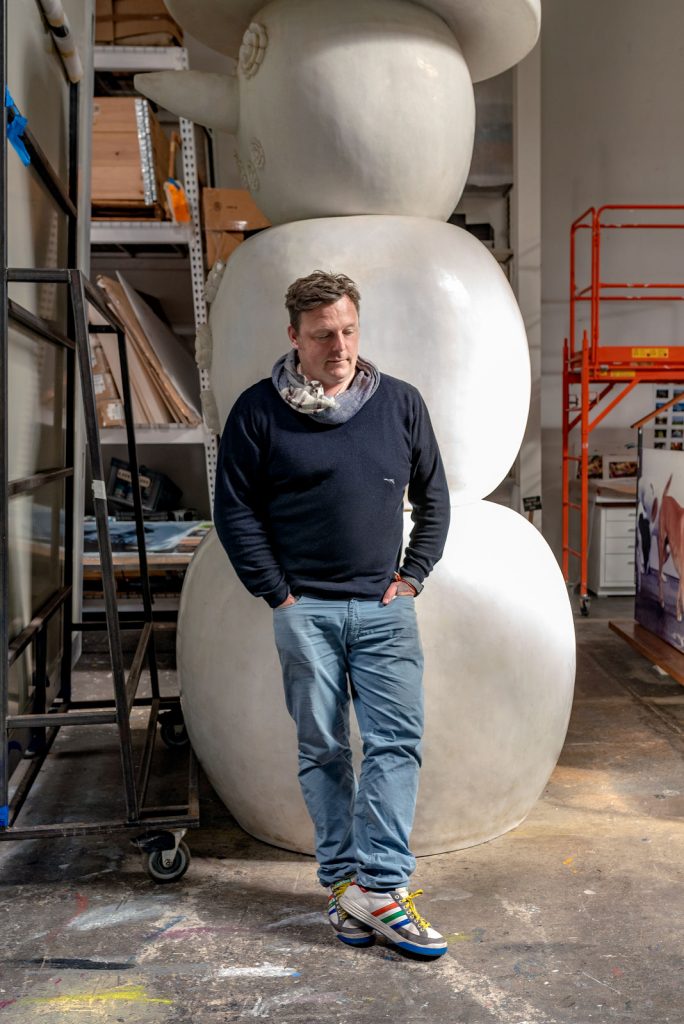

New York, 2015. All photos © Alexia Antsakli Vardinoyanni www.artflyer.net
